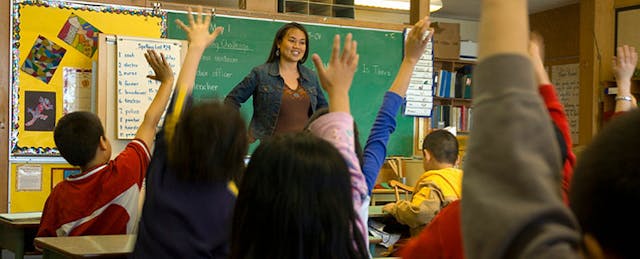We think a great learning tool includes three components: teaching, practice and analytics. So, we built these components into the Front Row Classroom, an adaptive math iPad app, and piloted it in ten classrooms in Baltimore, Chicago, and San Jose. The schools ranged from rich to poor, urban to suburban, and ethnically diverse to ethnically homogenous. Thanks to over 50,000 questions answered by our students and over 200 hours we spent in schools nationwide, we gained unique insight into the classroom.
1. Teaching
Going in, we had a very idealistic view of the relationship kids have with videos, so we made quite a few of them available, expecting them to be part of regular use. In reality, kids have a love-hate relationship with videos--you never know which video will speak to them, whether they’re interested in watching it, or whether they’ll pay attention to the whole thing. In general, we had a hard time getting kids to watch Khan Academy videos about fractions but a much easier time getting them to watch custom made videos using ShowMe. While both videos were delivered when the student was working on the appropriate topic, the latter was much more explicitly connected to the task at hand. This meant the motivation to watch the custom walkthroughs was higher; understanding it meant understanding how to do the question at hand.
While adaptive software focuses on students’ pace, it’s equally important to consider each student’s learning style as well. Some learn better through videos, others through text, others through explanations from their peers, and others directly from a teacher. Making sure each student has an appropriate avenue to progress through is key.
We also learned that one of the best ways to find out how kids learn is by asking them! Teachers were instrumental in getting us their students’ opinions. As it turns out, eight-year olds can be remarkably thoughtful, and some of the kids have the makings of future product managers!
2. Practice
Competition is a great motivator for students. In one of the early days of the pilot, we were looking for more ways to motivate and engage the students. So, we introduced a leaderboard, which was a spectacular hit. Suddenly, kids were trying as hard as they could to learn and beat their friends.
With a leaderboard, the most important thing is to incentivize hard work over success and to make sure that the students always have a way to climb back up the leaderboard even if they’re lagging behind (rubberbanding). The teachers loved the Front Row leaderboard because it was reset daily, and a different student was on top every day, and most of the time it wasn’t the smart kids.
The adaptive nature of Front Row helped us accomplish this: if students did well one day, they had harder problems to solve the next day, making it more difficult to accumulate leaderboard status. But if they did poorly, they got even more of the same type of question. And in the process of proving to the app that they really do understand the topic, they got many more questions right, allowing them to climb to the leaderboard more easily. This cycle repeats itself day after day, creating a high level of social-leaderboard mobility.
The smart kids who are usually on top of the heap liked this despite the downgraded status. For once, they had an exciting challenge to work on and worthy opponents to compete against.
As the students practiced using the app, it became obvious to us that classrooms are fast paced, and they get even faster when software is involved. We’ve been trained to do things quickly on computers and iPads: the challenge is to create an educational tool when, with software, “most of the time we don’t choose the best option--we choose the first reasonable option," writes UX expert, Steve Krug. This is even more true of the kids who were born into the internet age.
3. Analytics
Even teachers sold on data aren’t quite sold on data. Detailed student data is exciting and empowering, but in practice it’s also extremely daunting. It’s a lot of work to look through that data, let alone make teaching decisions based on it. And, oftentimes, it’s just simpler to teach everyone the same thing, just like before. At the start of the pilots, our dashboard was the kitchen sink: detailed student data about every topic, sub-topic, and sub-sub-topic, detailed data about practice sessions, and averages for the class. We quickly learned that when it comes to dashboards, more is definitely not better.
So, we talked to the teachers a lot, and went back to the drawing board. Now, rather than throwing all this data at the teacher, we focus on giving the teachers the results they need to see: names of kids who are struggling, and those who are behind; names of students that can be taught in a small group lesson, along with what they need to be taught; and which concepts large portions of the class struggle with. The focus is now on actions the teacher can take rather than things the teacher should know.
Takeaways
Teachers are critical to improving student outcomes, but they’re in short supply. Instead of wasting their time lecturing the same thing to everyone, we need to make sure they’re deployed where they are needed most. If developers pay attention to learning styles, adaptive difficulty, and how they handle data, adaptive software can transform the classroom--saving teachers time by making up for variations in student performance.


